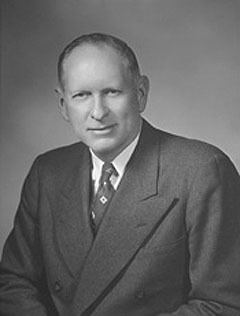Role American Politician | Name Thomas Stanley Succeeded by G. Alvin Massenburg | |
 | ||
Died July 10, 1970, Stanleytown, Virginia, United States | ||
Succeeded by J. Lindsay Almond, Jr. | ||
Thomas Bahnson Stanley (July 16, 1890 – July 10, 1970) was an American politician, manufacturer and Holstein cattle breeder. He served in a number of different political positions in Virginia, including serving as the 57th Governor of the state.
Contents

Early life
He was born to Crockett Stanley (January 8, 1838 – March 12, 1915) and Susan Matilda Walker (August 17, 1845 – April 9, 1922) on a farm near Spencer, Henry County, Virginia, youngest of seven children. He married Anne Pocahontas Bassett (November 28, 1898 – October 20, 1979) on October 24, 1918 in Bassett, Virginia. Anne was the daughter of John David Bassett (July 14, 1866 – February 26, 1965), a founder of Bassett Furniture, and Nancy Pocahontas Hundley (November 21, 1862 – January 11, 1953). Stanley graduated from Eastman Business College in Poughkeepsie, New York in 1912.
Business
Stanley worked for his father-in-law's company, Bassett Furniture, as an executive, until 1924, when he left and founded Stanley Furniture, a leading Virginia furniture maker, in what would become Stanleytown, Virginia. His sons Thomas Bahnson Stanley, Jr. and John David Stanley joined him at Stanley Furniture.
Politics
As the Democratic candidate he defeated Republican Theodore Roosevelt Dalton and Independent Howard Carwile in the general election for Governor of Virginia in 1953. He served as the Governor of Virginia from 1954 to 1958. Before becoming governor, Stanley was the Speaker of the Virginia House of Delegates and a U.S. Representative in Congress from November 5, 1946, filling vacancy created when Thomas G. Burch resigned to assume U. S. Senate seat, until Stanley resigned on February 3, 1953 to run for Virginia's governor. As governor Stanley improved the administration of state hospitals and increased funding to mental hospitals and public schools.
While governor Stanley became embroiled in conflict. The budget fight between the Old Guard and the Young Turks over budget surpluses in the 1954 legislative session colored relations in the Democratic Party for a generation. Brown v. Board of Education was decided during his term, and his initial efforts to preserve segregation through legislative means were hamstrung by U.S. Senator Harry Byrd, Sr., and his Massive Resistance campaign.
Electoral history
Death
He died in Martinsville, Virginia on July 10, 1970 and is buried in Roselawn Burial Park. His home Stoneleigh was listed on the National Register of Historic Places in 1982.
